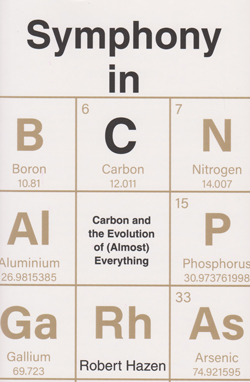
At school we learnt that carbon is element 6 in the periodic table, has two allotropes, diamond and graphite (now more), is the base of organic chemistry, has many chemical combinations and molecular shapes and, as salts, such as carbonates, forms beautiful crystals. In truth, carbon is everywhere—in Earth's core, the sea, atmosphere, materials and us. There is thus a much wider story concerning carbon and Robert Hazen in
Symphony in C gives it. Hazen is a carbon scientist, currently the Executive Director of the Deep Carbon Observatory (DCO), which is a large global community dedicated to understanding the origins of carbon, its forms, movement and quantities inside Earth. So, who better to tell this story?
Symphony in C enthusiastically discusses many of the topics in suitably grouped chapters. Hazen starts by introducing the DCO and how this book was motivated. Essentially, as he is a symphony musician (trumpet) his appreciation of musical compositions inspired him to write this book as a symphony, but in words not music. As with a musical symphony,
Symphony in C has four movements (chapters). Movement I, 'Earth', begins with the 'Big Bang', (about 14 billion years ago) and how atoms of carbon were forged from smaller atomic bits. Then at 4.5 billion years ago, planet Earth formed. The chapter progresses to discussing rocks and minerals and the beauty of crystalline carbon compounds. Movement II, 'Air', examines first the origin of Earth and its atmosphere, then the whole carbon cycle, as carbon moves through Earth’s interior via the mantle, oceans, volcanoes and atmosphere, and finishes with climate change via carbon dioxide and methane. Movement III, 'Fire', shows how carbon pervades every aspect of our lives (stuff), including energy, polymers, rubber, glue, nanotubes, graphene, food, clothes and plastics, useful or otherwise. Finally, Movement IV, 'Water', explores how carbon is essential for the element of life, its origins and evolution (biological processes), and predicts (p245) that Earth will go on no matter what injuries we do to it. There is, though, much more.
Hazen has an enthusiastic approach in clear language. A recent sample of his style is his special public lecture,
https://www.geolsoc.org.uk/GSL-Special-Lecture-Feb. He often makes his point through a human story by tying the topic to a particular research person. However, although the style is easy, appreciation of some of the content needs a science background. There is no index, but the notes give many sources.
I enjoyed expanding my learning of the magnificence of carbon.
Symphony in C could be a bedtime read, a passing of a long journey or otherwise a dip.
Reviewed by Richard Dawe
SYMPHONY IN C: CARBON AND THE EVOLUTION OF (ALMOST) EVERYTHING, by Robert Hazen, 2019. Published by: William Collins, London. 268pp. (hbk) ISBN: 9780008292386
List price: £20.00
W: www.harpercollins.co.uk